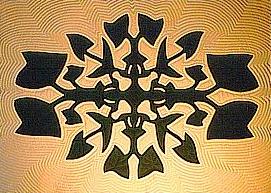America's Quilting History
Traditional Quilts From the Hawaiian Isles

As early as 1820 native Hawaiian women learned to make quilts from missionaries. The early quilts were pieced. These patchwork quilts continue to be made for everyday quilts even today. Quilts made of scraps of fabric must have seemed strange to the native women compared to their traditional bedcovering made of kapa, a cloth made from the inner bark of native trees. Strips of this inner bark were beaten and felted together to make it into a cloth that was smooth and soft to the skin. Four or five sheets of kapa became a bedcovering called kapa moe. Often the kapa was scented with fragrances made from native flowers. The top sheet of kapa was dyed and stamped with an overall design.
It was natural that Hawaiian women would want to incorporate these kapa moe designs into their quilts. By 1860 the traditional Hawaiian Quilt emerged. Cotton fabric had become more available with the westernization of Hawaii. This made it possible to create quilts with appliqué on solid cloth. These appliquéd quilts had a single design radiating symmetrically from the center covering the whole quilt. The pattern was made much like we might make a cut paper snowflake but with cloth. These quilts were usually made with two solid colors, one for the background and one for the appliquéd design.
Hawaiian women had created a style of quilting that was uniquely their own based on the designs used on traditional kapa cloth. Inspiration for many of the designs on these quilts came from the natural beauty of the Hawaiian Islands. The use of curved lines and plant like motifs resulted in an intricate, organic composition that was often based on local vegetables or flowers including interesting leaf patterns.
The designing of a quilt was a very personal thing. Women occasionally shared their designs with a special friend or relative but copying a quilt without permission was very much frowned upon. Women often created a certain design based on something she had observed or a significant event. Dreams were considered an inspired source for quilt design. Linda Moriarity, a Hawaiian native, wrote, "My own grandmother related such an experience, when a dream gave her the vision for a quilt. The following morning she got up and immediately sketched the design, developing the pattern by the end of the day." 1
Thousands of fine, hidden stitches were required in order to appliqué' the design onto the cloth. Yet this extensive appliqué was only part of the detailed work that went into making these marvelous quilts. Next the layers had to be quilted together. Sometimes straight or diagonal lines were used but more often echo quilting was done. This technique repeated the shape of the original design in a closely radiating pattern. In 1933 a speaker drew attention to a quilt maker in an exhibition of Hawaiian quilting. She pointed out, "Mrs. Montgomery can sew very fast and still make her stitches small and even; she follows the pattern freehand. I want you to notice how cleverly she conceals the knot in the stuffing of the quilt." 2 As you can imagine, these quilts were extremely time consuming and demand a great deal of skill and patience.

Each quilt was given a name, often reflecting the inspiration behind the design. Because of the tradition of individually designed quilts innumerable unique Hawaiian Quilts have been made over the years. Fortunately many of these intriguing quilts have survived as they were only used for special occasions and then passed on from generation to generation.
Hawaiian natives have developed another unique quilt form, one that uses the Hawaiian Flag and other symbols of Hawaiian royalty in its design. These quilts honor the short-lived Hawaiian Kingdom. Local Americans overthrew the monarchy in 1893 though it was not formally annexed by the United States until 1898. These quilts are often referred to as "My Beloved Flag" and even today are highly valued by the island families that own them.
During the late 1800s and early 1900s Hawaiian women made crazy quilts and outline embroidery quilts just as women on the mainland did. While following popular quilting styles of the time we find that some aspects of these quilts reflect Hawaiian culture. Motifs embroidered on crazy quilts included crowns like those used on flag quilts, fish and birds. Outline embroidered quilts were predominantly floral compared to greater variety of motifs on the mainland. The popular Hawaiian symbol, Coat of Arms, was centered on several of these embroidered quilts.
But don't think of Hawaiian quilting as something from the distant past. Rather it has continued to be done through the years and the art of making a traditional Hawaiian Quilt is still popular today.
© 2004 Anne Johnson (Do not reproduce any material from this site without permission.)Thank you to Nancy Lee Chong, the appliquér and quilter of the pictured Hawaiian Flag Quilt, for permission to use it on this page. Nancy is a quiltmaker, teacher, lecturer, author, and designer specializing in Hawaiian Quilts and Needleturn Appliqué. Visit the PACIFIC RIM QUILT COMPANY to learn about the classes she teaches and to purchase her patterns.
References:
1 p181"To Honor and Comfort: Native Quilting Traditions", by Marsha MacDowell (Editor), C. Kurt Dewhurst (Editor)
2 p62 "The Wilcox Quilts in Hawaii", by Robert J. Schleck (Editor)
"Hawaiian Outline-Embroidered Quilts", by Loretta B. Hammonds Woodard, Uncoverings 1997
"Quilts a Living Tradition" by Robert Shaw



